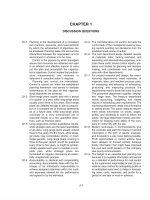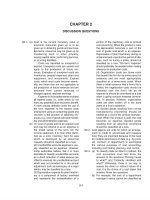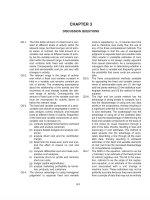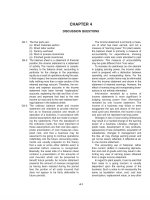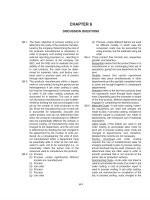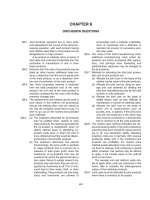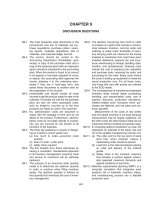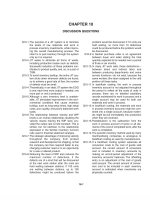Solution manual cost accounting 14e by carter ch10
Bạn đang xem bản rút gọn của tài liệu. Xem và tải ngay bản đầy đủ của tài liệu tại đây (88.18 KB, 17 trang )
To download more slides, ebook, solutions and test bank, visit
CHAPTER 10
DISCUSSION QUESTIONS
Q10-1.The purpose of a JIT system is to minimize
the levels of raw materials and work in
process inventory investments, while improving the overall manufacturing process. The
intent is to pull inventory through the system
only as it is required.
Q10-2.JIT seeks to eliminate all forms of waste,
including production losses such as defects.
Successful reduction of these problems contributes to product quality, and, so, is a part of
TQM.
Q10-3.To avoid inventory buildup, the entire JIT system shuts down whenever defects are found;
so to achieve a good rate of flow, the number
of defects must be small.
Q10-4.Theoretically, in an ideal JIT system the EOQ
is one; each time more output is needed, one
more part or unit is produced.
Q10-5.Although a zero inventory level is unattainable, JIT stimulates improvement in the environmental conditions that cause inventory
buildup, such as long setup times, high setup
costs, poor quality, and poorly balanced work
loads.
Q10-6.The relationship between velocity and WIP
levels is an inverse relationship; doubling the
velocity means halving the WIP level, provided the output rate is held constant. This is
similar, but not identical, to the relationship
expressed in the familiar inventory turnover
ratio used in financial statement analysis.
Q10-7.The strategic advantage of improving velocity
throughout the company, from product
research and development to shipping, is that
the company can then respond faster to any
changing customer need or to an opportunity
for a new or altered product.
Q10-8.Reducing the level of WIP also reduces the
maximum number of defectives, if the
defects are of a kind that will be discovered
at the next work station after the units are
held waiting between stations. If 100 units
are waiting between stations, up to 100
defectives might be produced before the
problem would be discovered; if 10 units are
held waiting, no more than 10 defectives
could be produced before the problem would
be discovered.
Q10-9.A blanket purchase order is an agreement
between buyer and seller stating the total
quantity expected to be needed over a period
of three or six months.
Q10-10.In many JIT work cells, these distinctions—
between direct and indirect labor and
between producing departments and some
service functions—do not exist, because the
same workers (the team assigned to the cell)
perform all these tasks.
Q10-11.In backflush costing, the work in process
inventory account is not adjusted throughout
the period to reflect all the costs of units in
process; there are no detailed subsidiary
records maintained for work in process; and a
single account may be used for both raw
materials and work in process.
Q10-12.In backflush costing, the materials and work
in process inventory accounts might be combined into a single account, because materials might be put immediately into production
when they are received.
Q10-13.Postdeduction is the subtraction from the
work in process account of some or all elements of the cost of completed work, after the
work is completed.
Q10-14.The periodic inventory method used by many
merchandising companies is analogous to
backflush costing as used by manufacturers.
Q10-15.If a backflush costing system expenses all
conversion costs to the cost of goods sold
account, the correct amount of conversion
cost is included in inventory accounts by
making an end-of-period adjustment of the
inventory accounts’ balances. The offsetting
entry is an adjustment of the cost of goods
sold account. The correct amount of conversion cost to be included in each inventory
account is estimated when inventories are
physically counted.
10-1
To download more slides, ebook, solutions and test bank, visit
10-2
Chapter 10
EXERCISES
E10-1 The expected annual savings are $40,500, consisting of $18,000 carrying costs
savings and $22,500 savings in the cost of defects, calculated as follows:
Carrying cost savings
=
=
=
=
25% × reduction in average variable cost of WIP
25% × 30% × past average variable cost of WIP
.25 × .3 × (10 × 300 × $80)
$18,000
Savings in cost of defects
= $25 × reduction in number of defective units
= $25
×
(reduction in
number of
defective units
produced per
undiscovered
out-of-control
condition)
= $25 × (30% × 300 × 5%)
= $25 × 4.5 × 200
= $22,500
×
×
(number of out-ofcontrol conditions
not discovered
immediately)
(1/3 × 600)
E10-2 The average lead time will be 26 days, calculated as follows:
Reduction of vendor lead time = 1/6 × 18 days = 3 days
Because the rate of output will be unchanged, a reduction of WIP to one-third of
its present level will triple the velocity. The average order will then remain in WIP
only one-third as long, saving two-thirds of time presently being spent in WIP:
Reduction of time in WIP
New lead time
= 2/3 of present time in WIP
= 2/3 × 12 days
= 8 days
= present lead time – reductions
= 37 days – (3 days + 8 days)
= 26 days
This approach can be used even if the other components of total lead time,
such as the two days in final inspection, are not stated. If all the components of
total lead time are known, as in this exercise, then the new lead time can be calculated by adding all its components:
(5/6 × 18) + 2 + (1/3 × 12) + 2 + 3 = 15 + 2 + 4 + 2 + 3
= 26 days
To download more slides, ebook, solutions and test bank, visit
Chapter 10
10-3
E10-3 The expected annual savings is $2,200,000, calculated as follows:
Doubling the velocity of all tasks, from receipt of order to shipment and from
ordering materials to issuing materials to production, will reduce WIP and materials inventories by half, therefore:
Reduction in materials carrying costs
Reduction in WIP carrying costs
= 20% × materials reduction
= 20% × (1/2 × $3,000,000)
= $300,000
= 20% × WIP reduction
= 20% × (1/2 × $5,000,000)
= $500,000
This change will also reduce customer lead time from eight weeks to four weeks.
Because customers are willing to wait up to five weeks for shipment, all shipments can then be made-to-order. There will no longer be a need for finished
goods inventory. Once the existing finished goods inventory is liquidated by
sales or scrapping, the annual savings from not carrying finished goods will be:
Reduction in finished goods carrying costs
= 20% × finished goods reduction
= 20% × (100% × $7,000,000)
= $1,400,000
Total savings = $300,000 + $500,000 + $1,400,000 = $2,200,000
(This exercise is based closely on an actual case of a partial JIT implementation.
The name of the company and dollar amounts have been altered.)
E10-4
(1)
(a)
(b)
(c)
(2)
Equivalent production = 4,500 + (.50 × 20) = 4,510 units;
$300, 740
= $66.683 per unit
4, 510
$300, 000
= $66.667 per unit
4, 500
units started = 4,500 + 20 – 24 = 4,496 units;
$300, 000
= $66.726 per unit
4, 496
$667, because 20 × .50 × $66.683 = $666.83.
$667, because 20 × .50 × $66.667 = $666.67.
$667, because 20 × .50 × $66.726 = $667.26.
To download more slides, ebook, solutions and test bank, visit
10-4
Chapter 10
E10-4 (Concluded)
(3)
Considering that the results of requirement (2) were the same (to the nearest dollar) for all three methods, then method (1) (b) would be recommended because
of its ease and simplicity. Method (1) (c) is a close second choice, also because
of ease and simplicity.The details of method (1) (a) may not be justifiable in these
circumstances.
(4)
Processing speed is very fast, with the result that work in process inventory levels are kept to a very low level—both in absolute terms and in relation to total
production activity for a month.
E10-5 Journal entries involving RIP and/or finished goods are:
Raw and in Process......................................................
Accounts Payable ................................................
456,000
456,000
A summary entry for all receipts of raw materials during the period. When
direct materials are used, no entry is needed, because the materials
remain in RIP.
Finished Goods ............................................................
Raw and in Process.............................................
455,000
455,000
To backflush material cost from RIP to finished goods. This is a postdeduction. The calculation is:
Material in May 1 RIP balance ...................
Material received during May ....................
Material in May 31 RIP, per physical count
Amount to be backflushed ........................
Cost of Goods Sold......................................................
Finished Goods ...................................................
$ 19,000
456,000
$475,000
20,000
$455,000
461,000
461,000
To backflush material cost from finished goods to cost of goods sold. This
is a postdeduction. The calculation is:
Material in May 1 finished goods .............
Material backflushed to finished goods...
Material in May 31 finished goods, per
physical count ............................................
Amount to be backflushed .................................
$ 16,000
455,000
$471,000
10,000
$461,000
To download more slides, ebook, solutions and test bank, visit
Chapter 10
10-5
E10-5 (Concluded)
Cost of Goods Sold......................................................
Raw and in Process.............................................
Finished Goods ...................................................
1,700
200
1,500
Conversion cost in RIP is adjusted from the $2,300 of May 1 to the $2,100
estimate at May 31. Conversion cost in finished goods is adjusted from the
$6,500 of May 1 to the $5,000 estimate at May 31. The offsetting entry is
made to the cost of goods sold account, where all conversion costs were
charged during May.
E10-6 The journal entries involving RIP and/or finished goods are:
Raw and in Process......................................................
Accounts Payable ................................................
222,000
222,000
A summary entry for all receipts of raw materials during the period. When
direct materials are used, no entry is needed, because the materials
remain in RIP.
Finished Goods ............................................................
Raw and in Process.............................................
221,500
221,500
To backflush material cost from RIP to finished goods. This is a postdeduction. The calculation is:
Material in June 1 RIP balance .................
Material received during June...................
Material in June 30 RIP, per physical count
Amount to be backflushed .......................
$ 10,500
222,000
$232,500
11,000
$221,500
Cost of Goods Sold......................................................
Finished Goods ...................................................
223,500
223,500
To backflush material cost from finished goods to cost of goods sold. This
is a postdeduction. The calculation is:
Material in June 1 finished goods ............
Material backflushed from RIP ..................
Material in June 30 finished goods, per
physical count ...................................
Amount to be backflushed ........................
$
8,000
221,500
$229,500
6,000
$223,500
To download more slides, ebook, solutions and test bank, visit
10-6
Chapter 10
E10-6 (Concluded)
Raw and in Process......................................................
Finished Goods ...................................................
Cost of Goods Sold.............................................
600
500
100
Conversion cost in RIP is adjusted from the $1,200 of June 1 to the $1,800
estimate at June 30. Conversion cost in finished goods is adjusted from
the $4,000 at June 1 to the $3,500 estimate at June 30. The offsetting entry
is made to the cost of goods sold account, where all conversion costs
were charged during June.
E10-7 Journal entries involving the RIP account are:
Raw and in Process......................................................
Accounts Payable ................................................
200,000
200,000
A summary entry for all receipts of raw materials during the period. When
direct materials are used, no entry is needed, because they remain a part
of RIP.
Finished Goods ............................................................
Raw and in Process.............................................
199,800
199,800
To backflush material cost from RIP to Finished Goods. This is a postdeduction. The calculation is:
Material in March 1 RIP balance ...............
Material received during March.................
9,000
200,000
$209,000
Material in March 31 RIP, per physical count
9,200
Amount to be backflushed ........................
$199,800
Raw and in Process......................................................
Cost of Goods Sold.............................................
$
300
300
Conversion cost in RIP is adjusted from the $1,000 of March 1 to the $1,300
estimate at March 31. The offsetting entry is made to the cost of goods
sold account, where all conversion costs were charged during March.
To download more slides, ebook, solutions and test bank, visit
Chapter 10
10-7
E10-8 Journal entries involving the RIP accounts are:
Raw and in Process......................................................
Accounts Payable ................................................
367,000
367,000
A summary entry for all receipts of raw materials during the period. When
direct materials are used, no entry is needed, because they remain a part
of RIP.
Finished Goods ............................................................
Raw and in Process.............................................
365,400
365,400
To backflush material cost from RIP to Finished Goods. This is a postdeduction. The calculation is:
Material in April 1 RIP balance..................
Material received during April...................
Material in April 30 RIP, per physical count
Amount to be backflushed ........................
Raw and in Process......................................................
Cost of Goods Sold.............................................
$ 29,600
367,000
$396,600
31,200
$365,400
400
400
Conversion cost in RIP is adjusted from the $1,400 of April 1 to the $1,800
estimate at April 30. The offsetting entry is made to the cost of goods sold
account, where all conversion costs were charged during April.
E10-9 Journal entries involving the RIP accounts are:
Raw and in Process ....................................................
Accounts Payable ................................................
246,000
246,000
A summary entry for all receipts of raw materials during the period. When
direct materials are used, no entry is needed, because they remain a part
of RIP.
Cost of Goods Sold......................................................
Raw and in Process.............................................
247,000
247,000
To backflush material cost from RIP to Cost of Goods Sold. This is a postdeduction. The calculation is:
Material in May 1 RIP balance ...................
Material received during May ....................
Material in May 31 RIP, per physical count
Amount to be backflushed ........................
$ 11,000
246,000
$257,000
10,000
$247,000
To download more slides, ebook, solutions and test bank, visit
10-8
Chapter 10
E10-9 (Concluded)
Raw and in Process......................................................
Cost of Goods Sold.............................................
800
800
Conversion cost in RIP is adjusted from the $1,300 of May 1 to the $2,100
estimate at May 31. The offsetting entry is made to the cost of goods sold
account, where all conversion costs were charged during May.
E10-10
(1)
The most recent purchase involved a quantity greater than the total materials in
ending inventories, and that purchase gives a cost of materials of
$420,000/1,400, or $300 per unit of output; therefore,
Materials cost of finished goods ending inventory
= 50 units × $300 per unit = $15,000
(2)
The conversion cost per unit is calculated by dividing the total conversion cost
by (a) the number of units started, (b) the number completed, or (c) the number
completed plus the number of partially converted units in the RIP ending inventory (not an equivalent units calculation):
(a)
(b)
(c)
(3)
$290,160 ÷ 3,000 = $96.72 conversion cost per unit
$290,160 ÷ 3,100 = $93.60 conversion cost per unit
$290,160 ÷ 3,120 = $93.00 conversion cost per unit
The three possible amounts for the conversion cost of the 50 units in finished
goods ending inventory are:
50 units @ $96.72 = $4,836 of conversion cost
50 units @ $93.60 = $4,680 of conversion cost
50 units @ $93.00 = $4,650 of conversion cost
(4)
Lowest = $15,000 materials + $4,650 conversion = $19,650
Highest = $15,000 materials + $4,836 conversion = $19,836
Dollar difference = $19,836 – $19,650 = $186
Difference, to nearest 1/10 percent = $186 ÷ $19,650 = 0.9%
To download more slides, ebook, solutions and test bank, visit
Chapter 10
10-9
E10-11
(1)
A $300 materials cost per unit was calculated in requirement (1) of the previous
exercise; therefore,
Materials cost of RIP ending inventory = 220 units × $300 per unit = $66,000
(2)
The three possible amounts for the conversion cost of the RIP ending inventory
of 20 units, 50% converted, are:
20 units × 50% × $96.72 = $967.20 of conversion cost
20 units × 50% × $93.60 = $936 of conversion cost
20 units × 50% × $93.00 = $930 of conversion cost
It seems inconsistent to assign 50% conversion costs to RIP when the units in
RIP were counted as whole physical units in the denominator of the conversion
cost per unit calculation in requirement 2(c) of E10-10, and when they were not
counted at all in the denominator of the calculation in requirement 2(b) of E1010. But the total dollar difference assigned to RIP is immaterial. Whatever the
amount of conversion costs assigned to RIP and finished goods, the remainder
of total conversion costs simply remains in cost of goods sold.
Lowest = $66,000 materials + $930 conversion = $66,930
Highest = $66,000 materials + $967 conversion = $66,967
Dollar difference = $66,967 – $66,930 = $37
Difference, to nearest 1/10 percent = $37 ÷ $66,930 = .1%
To download more slides, ebook, solutions and test bank, visit
10-10
Chapter 10
PROBLEMS
P10-1
(1)
The expected annual savings are $720,000, consisting of $384,000 carrying
costs savings and $336,000 savings in the cost of defects, calculated as follows:
Carrying cost savings
=
=
=
=
30% × reduction in average variable cost of WIP
30% × 40% × past average variable cost of WIP
.3 × .4 × (40 × 200 × $400)
$384,000
Savings in cost of defects
= $60 × reduction in number of defective units
(reduction in number
= $60 ×
of defective units ×
produced per
undiscovered flaw)
= $60 × (40% × 200 × 20%)
= $60 × 16 × 350
= $336,000
×
(number of flaws not
discovered immediately)
(1/4 × 1,400)
(2)
Likely benefits that are not assessable from the information given include the
following:
(a) Faster cycle time resulting from the higher velocity of WIP. (Because the rate
of final output will not change, velocity will change inversely with the change
in WIP levels.) The faster cycle time will improve the speed with which orders
can be filled, thus increasing customer satisfaction and perhaps increasing
perceived product value so that prices can be raised (or price cuts delayed
or avoided).
(b) If, as a result of the shorter cycle time, total lead time becomes less than the
time customers are willing to wait for an order, then the company would no
longer need to maintain a finished goods inventory. This possibility would
result in additional savings in floor space and other inventory carrying costs.
(The value of the floor space freed up by eliminating 40% of WIP storage is not
an additional benefit; inventory carrying costs include storage costs, so the
value of the floor space is included in the carrying cost savings calculated in
requirement (1).)
(3)
Costs and other negatives to be compared with the savings include:
(a) The increased likelihood of shutdowns due to work locations being starved
for WIP; lower WIP levels at each station represent lower safety stocks, so
stockouts are more likely at all locations.
To download more slides, ebook, solutions and test bank, visit
Chapter 10
10-11
(b) The cost of starting a larger number of batches or lots into production,
which includes the cost of processing more work orders, production orders,
and material requisitions. (To reduce average WIP size, either smaller
batches must be started at shorter intervals, or protracted stockouts must
be allowed to occur; otherwise, the average size of WIP will not drop.)
(c) The cost of handling more loads of materials. If lot sizes are small enough
to require only one load per lot both before and after the change, then a
larger number of lots will result in a larger total number of loads.
(d) The cost of performing a larger number of setups to permit running a larger
number of batches or lots of smaller size. Ideally, as part of the JIT implementation, setup cost will be driven down to eliminate this problem.
P10-2
(1)
Protech could achieve an average lead time on these orders of 42 days, calculated as follows:
Reduction of time in WIP =
=
=
=
3/4 of present time in WIP
3/4 × (360 days ÷ 10)
3/4 × 36 days
27 days
Reduction of vendor lead time = 1/3 × 27 days = 9 days
New lead time = present lead time – reductions
= 78 days – (27 days + 9 days)
= 42 days
Note: It is not stated that Protech defines WIP and WIP turnover in a way that
excludes the two days spent in receiving and the three days spent in final
inspection.To check that the average cycle time of 360 days/10, or 36 days, does
exclude those steps (so that there is no double-counting), note that a cycle time
of 36 days, when added to the other intervals mentioned, gives the stated total
lead time of 78 days: 6 + 27 + 2 + 36 + 3 + 4 = 78.
(2)
The advantages of shorter lead time include:
(a) The value of the floor space freed up by eliminating three-fourths of WIP
storage.
(b) Improvement in the speed with which orders can be filled, which should
increase customer satisfaction and perhaps increase perceived product
value so that prices can be raised (or price cuts delayed or avoided).
(c) If the new 42-day total lead time is less than the time customers are willing
to wait for an order, then the company would no longer need to maintain a
finished goods inventory. This possibility would result in additional savings
in floor space and other inventory carrying costs.
To download more slides, ebook, solutions and test bank, visit
10-12
Chapter 10
P10-2 (Concluded)
(3)
Costs and other negatives to be compared with the savings include:
(a) The increased likelihood of shutdowns due to work locations being starved
for WIP; lower WIP levels at each station represent lower safety stocks, so
stockouts are more likely at all locations.
(b) The cost of starting a larger number of batches or lots into production,
which includes the cost of processing more work orders, production orders,
and material requisitions. (Reducing average WIP size generally requires
starting smaller batches at shorter intervals.)
(c) The cost of handling more loads of materials. If lot sizes are small enough
to require only one load per lot both before and after the change, then a
larger number of lots will result in a larger total number of loads.
(d) The cost of performing a larger number of setups to permit running a larger
number of batches, or lots, of smaller size. Ideally, as part of the JIT implementation, setup cost will be driven down to eliminate this problem.
(e) The time and effort that may be required to induce vendors to reduce their
lead time by one-third.
P10-3
(1)
(a)
Raw and in Process.............................................
Accounts Payable .......................................
850,000
850,000
A summary entry for all receipts of raw materials during the period.
When direct materials are used, no entry is needed, because they
remain a part of RIP.
(b)
(c)
(d)
Factory Overhead Control ..................................
Supplies.......................................................
Indirect materials are recorded as used.
13,000
Payroll ...................................................................
Accrued Payroll ..........................................
400,000
Accrued Payroll ...................................................
Cash .............................................................
400,000
Cost of Goods Sold.............................................
Factory Overhead Control ..................................
Marketing Expenses Control ..............................
Administrative Expenses Control ......................
Payroll ..........................................................
60,000
120,000
130,000
90,000
13,000
400,000
400,000
400,000
Direct labor is expensed to the cost of goods sold account.
(e)
Factory Overhead Control ..................................
Accumulated Depreciation ........................
Prepaid Insurance ......................................
681,000
668,000
13,000
To download more slides, ebook, solutions and test bank, visit
Chapter 10
10-13
P10-3 (Continued)
(f)
Factory Overhead Control ..................................
Cash .............................................................
Accounts Payable .......................................
(g)
Cost of Goods Sold.............................................
Factory Overhead Control .........................
83,000
54,000
29,000
897,000
897,000
Overhead is expensed to the cost of goods sold account.
(h)
Finished Goods ...................................................
Raw and in Process....................................
844,000
844,000
To backflush material cost from RIP to finished goods. This is a
postdeduction. The calculation is:
Material in June 1 RIP balance ........
Material received during June..........
Material in June 30 RIP, per physical
count ..........................................
Amount to be backflushed ...............
(i)
Cost of Goods Sold.............................................
Finished Goods ..........................................
$ 40,000
850,000
$890,000
46,000
$844,000
852,000
852,000
To backflush material cost from Finished Goods to Cost of Goods
Sold. The calculation is:
Material in June 1 Finished Goods ..
Material cost transferred from RIP ..
Material in June 30 finished goods,
per physical count....................
Amount to be backflushed ...............
(j)
Raw and in Process.............................................
Cost of Goods Sold.............................................
Finished Goods ..........................................
$ 190,000
844,000
$1,034,000
182,000
$ 852,000
300
1,700
2,000
Conversion costs in the inventory accounts are adjusted to the estimates made in the June 30 physical count. For RIP, the adjustment is
from the $1,600 of June 1 to $1,900 on June 30; for Finished Goods, the
adjustment is from the $180,000 of June 1 to $178,000 on June 30. The
offsetting entry is made to the cost of goods sold account, where all
conversion costs were charged during June.
To download more slides, ebook, solutions and test bank, visit
10-14
Chapter 10
P10-3 (Concluded)
(2) The three completed accounts are
6/1
(a)
(j)
6/30
6/1
(d)
(g)
(i)
(j)
6/30
P10-4
(1)
(a)
Raw and in Process
41,600 (h)
844,000
850,000
300
47,900
6/1
(h)
6/30
Finished Goods
370,000 (i)
852,000
844,000 (j)
2,000
360,000
Cost of Goods Sold
-060,000
897,000
852,000
1,700
1,810,700
Raw and in Process.............................................
Accounts Payable .......................................
620,000
620,000
A summary entry for all receipts of raw materials during the period.
As direct materials are used, no entry is needed, because they
remain a part of RIP.
(b)
Factory Overhead Control ..................................
Supplies.......................................................
10,000
10,000
Indirect materials are recorded as used.
(c)
(d)
Payroll ...................................................................
Accrued Payroll ..........................................
300,000
Accrued Payroll ...................................................
Cash ............................................................
300,000
Cost of Goods Sold.............................................
Factory Overhead Control ..................................
Marketing Expenses Control ..............................
Administrative Expenses Control ......................
Payroll ..........................................................
50,000
90,000
90,000
70,000
300,000
300,000
300,000
Direct labor is expensed to the cost of goods sold account.
(e)
(f)
Factory Overhead Control ..................................
Accumulated Depreciation ........................
Prepaid Insurance ......................................
523,000
Factory Overhead Control ..................................
Cash .............................................................
Accounts Payable .......................................
33,000
514,000
9,000
26,000
7,000
To download more slides, ebook, solutions and test bank, visit
Chapter 10
10-15
P10-4 (Continued)
(g)
Cost of Goods Sold.............................................
Factory Overhead Control .........................
656,000
656,000
Overhead is expensed to the cost of goods sold account.
(h)
Finished Goods ...................................................
Raw and in Process....................................
615,000
615,000
To backflush material cost from RIP to Finished Goods. This is a
post-deduction. The calculation is:
Material in May 1 RIP balance ..........
Material received during May ...........
Material in May 31 RIP,
per physical count....................
Amount to be backflushed ...............
(i)
Cost of Goods Sold.............................................
Finished Goods ..........................................
$ 30,000
620,000
$650,000
35,000
$615,000
605,000
605,000
To backflush material cost from Finished Goods to Cost of Goods
Sold. The calculation is:
Material in May 1 Finished Goods ...
Material cost transferred from RIP ..
Material in May 31 Finished Goods,
per physical count....................
Amount to be backflushed ...............
(j)
Raw and in Process.............................................
Finished Goods ...................................................
Cost of Goods Sold....................................
$ 150,000
615,000
$ 765,000
160,000
$ 605,000
800
4,000
4,800
Conversion costs in the inventory accounts are adjusted to the estimates made in the May 31 physical count. For RIP, the adjustment is
from the $1,300 of May 1 to $2,100 on May 31; for Finished Goods, the
adjustment is from the $130,000 of May 1 to $134,000 on May 31. The
offsetting entry is made to the cost of goods sold account, where all
conversion costs were charged during May.
To download more slides, ebook, solutions and test bank, visit
10-16
Chapter 10
P10-4 (Concluded)
(2) The three completed accounts are
5/1
(a)
(j)
5/31
5/1
(d)
(g)
(i)
5/31
Raw and in Process
31,300 (h)
615,000
620,000
800
37,100
5/1
(h)
(j)
5/31
Finished Goods
280,000 (i)
605,000
615,000
4,000
294,000
Cost of Goods Sold
-0- (j)
4,800
50,000
656,000
605,000
1,306,200
P10-5
(1)
Contribution margin of lost sales (20,000 units):
Revenue ($10,800 ÷ 900 units) ....................................
Variable costs:
Cost of sales ($4,050 ÷ 900) ...............................
Marketing and administrative ($900 ÷ 900) .......
Total variable cost ......................................
Unit contribution margin..............................................
Volume of lost sales .....................................................
Total contribution margin of lost sales .............
Overtime premiums (overtime cost is less than the
additional contribution margin of lost sales):
15,000 × $6.50 = $97,500 > $40,000....................
Rental savings ..............................................................
Rental income from owned warehouse
(12,000 × .75 × $1.50)..........................................
Elimination of insurance and property taxes ............
Opportunity cost of funds released from
inventory investment:
Investment in inventory ......................................
⎛
⎞
Interest before tax ⎜ .12 ⎟
⎝ 1− .40 ⎠
Estimated before-tax dollar savings...........................
$
12.00
$
4.50
1.00
$
5.50
$
6.50
× 20,000
$(130,000)
$ (40,000)
60,000
13,500
14,000
$ 600,000
.20
120,000
$ 37,500
To download more slides, ebook, solutions and test bank, visit
Chapter 10
10-17
P10-5 (Concluded)
(2)
Conditions that should exist in order for a company to install just-in-time inventory successfully include the following:
(a) Top management must be committed and provide the necessary leadership support in order to ensure a company-wide, coordinated effort.
(b) A detailed system for integrating the sequential operations of the manufacturing process needs to be developed and implemented. Raw materials
must arrive when needed for each subassembly, so that the production
process functions smoothly.
(c) Accurate sales forecasts are needed for effective finished goods planning
and production scheduling.
(d) Products should be designed to use standardized parts to reduce manufacturing time and reduce costs.
(e) Reliable vendors who can deliver quality raw materials on time with minimum lead time must be obtained.
